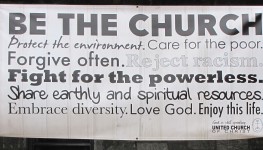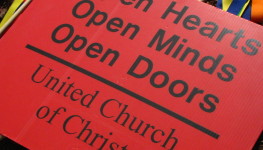“Losing What Was, Finding What Can Be”
John 20:1-18
I’m afraid I need to begin with a confession:
You see, I have a problem with the resurrection of Jesus—and it’s not just that it’s hard to believe.
It also seems too fast, too easy, and too, well, tidy.
I mean: One day the Word Made Flesh submits to a violent, dehumanizing, in-your-face, don’t-even-think-about-empowering-the-people political execution, leaving his devastated and terrified followers behind. And then, a couple days later, he’s out and about, looking like a gardener?
And where did the Risen Christ get those clothes, anyway?
I mean . . . I don’t know about you, but in my experience, that’s just not how life works. In the movies, maybe. In our dreams, maybe. In fairy tales and on TikTok, maybe.
But in real life?
I don’t know.
On the other hand, who am I to quibble with mystery?—especially a mystery that has shaped history, inspired movements, and sustained the fragile hope of mere mortals for more than two thousand years?
In a world where Barbie is a movie star, Birkenstocks are cool, the Earth is hotter but the California drought has ended, legions of Taylor Swift fans have made professional football a girl thing, scientists have discovered that awe and wonder are essential to our mental health, people everywhere have awoken to the pain of Palestine and Israel, and a disgraced former president is selling Bibles for $60 apiece, who am I to say what does and doesn’t make sense?
Who am I to say what is and isn’t possible, or to say how resurrection should happen?
The astonishing grace and goodness of God, and how it is always at work in the world in spite of everything, brings me to my knees on the regular.
All I’m saying is the resurrection might get a little more respect if it were more, let’s say, true to life as we know it. Maybe if it were more a fits-and-starts kind of thing, a let’s-try-again-and-keep-trying kind of thing, a route-recalculation kind of thing.
And would you believe it, that’s exactly the kind of new life we see in our lives and in our scriptures again and again.
Maybe you know the story of the prophet Elisha, who was called by a frantic mother to tend to her dead son, the very son who had been a surprise gift from God. At first Elisha thought restoring her son to life would be an easy fix, and so he sent his intern to handle it.
Nothing happened.
Beginning to think that the boy might be truly, seriously dead, Elisha went to him, closed the door, prayed, and did his best to transfer his own breath and life force to the boy’s lifeless body.
Again, nothing.
Then Elisha began pacing the floor and praying, and then he started all over from scratch.
Finally, the boy’s body began to stir. The boy sneezed seven times, and then he opened his eyes.
That kind of resuscitation feels familiar. Most of us who struggle to make our way through this life or to find our way back from wrong turns to what is good and true and life-giving know that the path is rarely smooth or glamorous.
We might fail multiple times in our efforts to get sober. We might think we’re over our grief only to find ourselves sitting on the bathroom floor sobbing in the middle of the night. We might lose at love and close our heart for years before finding the courage to try again. We might wonder if we can keep going amid so much evil and suffering in the world.
And then—by grace and hope, persistence and stubbornness, by learning to let go, and with the help of others—we too might, eventually, sneeze and snort our way back to the land of the living and loving and laughing.
Or what about that time some people brought a blind man to Jesus for healing? Jesus said a prayer, put some saliva on the man’s eyes, and asked him if he could see.
“Well,” the man said, “I think I see people but they look like walking trees.” And so Jesus tried again, laying his hands on the man’s eyes. Only then could the man see clearly.
Sometimes, apparently, God’s life-giving power doesn’t take on the first try. Sometimes we’re not quite ready for something new and wonderful. Sometimes our hurts and fears run deep, and we just can’t risk being disappointed again. Sometimes getting to a place of healing and wholeness requires multiple tries and more than a little surrender and trust.
But still, by God’s grace, it comes.
Still, by God’s love, new life comes—as long as we’re able to let go of the old and make room for what we can’t yet imagine.
Or what about Lazarus? Four days dead and stinking to high heaven when Jesus called him out of the tomb. And because Lazarus emerged still wearing his death clothes, Jesus called on the community to unbind him and receive him back into life.
Apparently, even when we’re so far gone that it seems there will be no coming back, love, community, and persistent faith can help us rise again. Apparently, God has baked both life and new life into how this world works. Into how we work.
And then there’s the so-called arc of history, the one we’re told is bending ever so slowly toward justice. Sometimes that arc bends sharply in the other direction: back toward violence and injustice, evil and suffering, human hatred and cruelty. It’s then that we wonder if we can take it anymore. It’s then we are tempted to stop caring, stop organizing, stop loving, stop giving, and stop hoping for anything different.
At that moment that we have one foot in the tomb. And it’s then that we have a decision to make: Will we surrender to the way things have always been, or will we gamble on God? Will we hunker down and play it safe, or will we risk it all for life and love?
This brings us, of course, to Mary Magdalene and the other disciples. The arc of history and redemption they had been joy-riding with Jesus had been all but destroyed. They had lost not only their beloved friend and teacher, but also all hope for the future. Jesus had been subjected to the most dehumanizing, demoralizing, and disempowering death, and for all they knew, they were next. No wonder they were hiding; they were terrified.
But then came Mary.
When I think about Mary going alone to the tomb—while it was still dark, while the Romans were still in charge, while the world was still a hot mess, while her own grief was raw and bottomless . . .
When I think about Mary going to the tomb fully expecting to find the stone still blocking the door, fully expecting to find Jesus still dead, but going anyway . . .
I begin to understand that God will never give up on me. I begin to see that God’s love will never give up on us. I begin to see God standing outside the tomb I have built, and I begin to see Jesus’ resurrection in a whole different light.
The resurrection was “tidy” and the turnaround from death to new life quick because the raising of Jesus from the dead was not the main event or the final act of the “God so loves the world” story.
That story is on-going, and the raising of Jesus from the dead was simply the beginning of a new act, a new community, and a new level of Spirit-filled human agency let loose in the world. Jesus’ resurrection was quick and relatively easy because it was time to get on with the loving and healing of the world.
The resurrection of Jesus set off a cascade of messy risings and transformations that began with Mary Magdalene—a woman!—running to tell the male disciples that she had seen the Lord. And that great torrent of death-defying power and life-giving joy still flows through human hearts hungry for hope, justice, and peace.
The resurrection of Jesus showed that God’s life-giving love is stronger than death, stronger than hate, stronger than empire, stronger than evil, stronger than fear, stronger than the very worst things we and all humanity are capable of.
Because I live, the Risen Christ says, you will, too. And with the Spirit to guide you and heal you, with the law of love written on your hearts, you will do even greater things than I’ve done.
When you love others the way that I’ve loved you, he says, when you let love change you from the inside out, when you come together in love and let love guide your every action, you will turn the world around: away from violence and vengeance, greed and death, and toward beloved community and life abundant for all.
Unlike Jesus’ resurrection, the raising of this new community and new way of being has not been quick or easy or, well, tidy.
For now, death still happens. Evil still exists. The human drive for power, wealth, and control still causes untold pain and suffering.
But because death could not contain me, the Risen Christ says, a light shines in the darkness. Because I rose again, there is meaning and joy to be found in loving the world with all your heart. Because Mary ran to tell the others, hope has legs. Because the others believed, the story spread throughout the earth. Because ever since then small communities of people have tried to follow my way of love, a new world remains possible.
Because I live within you, among you, and all around you, nothing will ever be able to separate you from the love of God.
And because I am in you and you are here—still hoping and loving, still showing up and hanging on—new life is forever being born, in all its messy holiness.
Alleluia! Alleluia! Alleluia!




